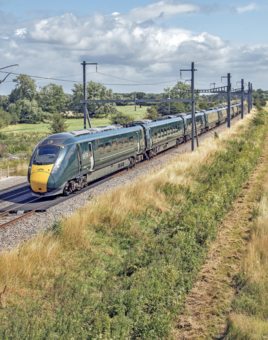NR Chief Mechanical & Electrical Engineer Phil Doughty says: “We have undertaken some high-level desktop analysis, which assumes we follow things as outlined in the Traction Decarbonisation Network Strategy. What do we see our power demand looking like, and what additional supply points will we need?”
Once there’s more certainly about the way forward, Network Rail will look in more detail at the regional traction demand power strategies, and then forecast what enhancements to the power supply will be needed in the future.
Says Doughty: “Routes which have the more modern autotransformer systems generally have enough spare capacity. It’s more the older conventional return conductor systems where there’s not much more headroom left. We know there are some existing pinch points on our network where we have more work to do.”
Much of the long-term planning for the energy industry is carried out by the Electricity System Operator (ESO), an arm’s length company owned by National Grid. It does both short-term energy demand modelling and long-term planning.
The National Grid Electricity Transmission business takes this work annually and then feeds into the next iteration with its own thoughts. And the Transmission business is already looking at what’s needed for the railways - particularly for traction current.
Nicola Shaw, President, UK Networks at National Grid, says: “Network Rail is one of our biggest customers, so we know what they are doing and where they are going to take electricity from the system.
“We have been modelling what might happen focused on those big routes, and those are the most obvious places for upgrades. We are pretty clear about what their capacity requirements are going to be and how many sub-stations we will have to build in the 2030s and 2040s to meet Network Rail’s additional needs.
Those forecasts, according to National Grid, are based in part on assumptions about the economics of electrification vs hydrogen and battery traction.
Already there’s an emerging picture about the CrossCountry rail network, which is likely to have a mixture of some sections where battery is the best solution and in other sections overhead lines, depending on their location.
The ideal scenario would clearly be that when connected to the catenary, batteries would be topped up to then be ready to run those sections where electrification either isn’t possible or is uneconomic. The same scenario could be the case for freight movements as well.
When it comes to actually getting the electricity lineside, Shaw says it’s already clear that there will have to be a significant upgrade of the transmission system to meet net-zero targets.
“We are going to have double the electricity flowing through the wires by 2050, but that doesn’t mean that we have to double the network. First, demand has dropped from its peak because of moves to become more energy-efficient, particularly in urban areas. There are also new technologies that are helping us manage power flows.”
National Grid also has the ability to upgrade wiring, rather than having to build new power networks.
Shaw explains: “There are a number of things you can do before you have to build more, but we certainly will have to build more.”
It’s thought that for overhead line electrification, a sub-station is needed roughly every 30 miles. Fortunately, for the railways, most towns and cities do have sub-stations, usually on the outskirts. And many of them are close to railway corridors.
For electrifying parts of the CrossCountry network in the Midlands, Richard Mann, Rail Programme Manager at the sub-national transport body Midlands Connect, says: “There’s a sub-station relatively near the railway in Oxford, there’s one relatively near the railway in Banbury, and another one near Warwick, so you kind of leap-frog from town to town. It’s all about cost, but there are enough sub-stations in the Midlands.”
However, it’s different in the North, where the railways pass through in more constrained sites and where there are more tunnels.
Another emerging option could be to use railway corridors as an additional electricity distribution network.
Shaw maintains that the electrical network that supports the railways is one of the biggest distribution networks in the UK, but it’s only set up for rail. She suggests that to gain more resilience and to get electricity to more far-reaching places, a parallel network could be built using railway corridors.
“It’s about making better use of the existing land that’s taken for infrastructure,” she says.












